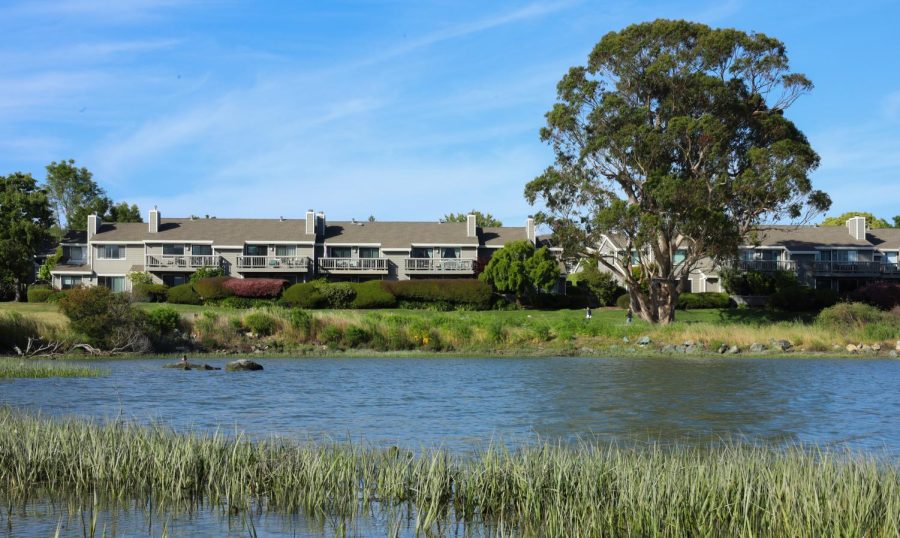Seawater, Minus the Salt Please
With climate change and growing concerns over drought, can seawater come to the rescue?
Houses stand behind the Corte Madera Creek in Greenbrae, Calif. on Monday, May 22, 2023. (Gina Castro / Xpress Magazine)
From agriculture to personal use, water is a precious resource that is often taken for granted. Showers that could be 10 minutes become 30, and cars are washed on hot summer days with hoses left on. Sink faucets are left open while lathering when they could be turned off. Water used to irrigate fields is used once, then left to run off into our streams and rivers.
California has experienced a strange few years of weather recently, and that is expected to continue in years to come. Reservoirs have reached record-breaking lows, causing the state to look to water alternatives like desalination. However, desalination is not a miracle solution and is riddled with energy and environmental consequences.
Desalination often uses a process called reverse osmosis. The process filters out contaminants, organic substances and salt using tremendous pressure to push seawater through a semipermeable membrane. The procedure is repeated multiple times until the final product, freshwater, is produced. That freshwater can potentially be used as drinking water or for agricultural use.
That being said, the process is highly inefficient. Although it may seem “green,” the process requires the burning of fossil fuels or large amounts of electricity to power the plant. “Desalination is super energy intensive. It involves taking in salt or brackish water, so water that has Halite and salt crystals in it, and pushing it under pressure through a membrane,” said SF State professor Nancy Wilkinson.
Wilkinson specializes in water resources, perception and environmental history.
“Between my masters and Ph.D. I worked for a water district and got really interested in water as sort of a theme that connected to my passion for environmental science,” said Wilkinson. She’s currently teaching a class on water at SF State where they look at water issues in California including annual rainfall and irrigation to see how water affects landscapes.
Her class also looks at water infrastructure like reservoirs and dams while focusing on what challenges remain or are being augmented by climate change. With recent droughts, Marin county has been the most affected and has started to expand their water collecting infrastructure out into Sonoma.
“Back in the drought in the ’70s, I remember Marin Municipal Water District installed an intertie across the Richmond Bridge to bring water in from EBMUD,” said Wilkinson.
Recently, Monterey approved a plan for a desalination plant near the town of Marina. The plan looks to provide potable and agricultural water for areas in the Salinas Valley. On paper, the project claims that it will provide water to communities with little to no water utilities, but Wilkinson is skeptical.
“It’ll be interesting to see if they actually use it for agriculture, the less salty the water is, the cheaper it is to do it…the more salty, the more expensive the project will cost,” Wilkinson said.
Everything has environmental costs. The construction of building dams has wiped out species of salmon and wetland species throughout the state in the past. In the case of desalination plants, the byproduct of the process produces brine, which is essentially water with an extremely high concentration of salt. That byproduct will then need to be put somewhere.
“If you put it back where you got it like the ocean or the bay, you’re adding water that’s much saltier than what you got originally,” said Wilkinson.
Wilkinson adds that most aquatic creatures are adapted to pretty narrow tolerances of temperature and salinity. So dumping brine back into the ocean or bay is going to be toxic for that ecosystem.
“Typically you want to get it further offshore into deeper, darker less productive parts, which is expensive and adds to the overall expense of the plant as well,” Wilkinson said.
The goal of most water projects is not only to collect water but to do so as cheaply as you can. So with a desalination plant, cheap is not the word Wilkinson would use.
Another factor is the energy needed to power a desalination plant. More often plants are powered by the burning of fossil fuels and occasionally by electricity.
Wilkinson suggests that if these plants were powered by renewables, it might make a difference. But more often than not, they are powered by fossil fuels, which contributes to the greenhouse effect.
Desalination plants also use a lot of plastic. The tubing for the plants is often made with PVC and membranes required for the reverse osmosis process are also made of plastic polymers. These plastics are petroleum based and contribute to our already worsening microplastic pollution and garbage problem.
“Desalination produces expensive water, so there will be environmental justice concerns about who can access that water,” said Wilkinson. With the potential plant in Monterey, Wilkinson feels that a potable water supply seems more likely, as for agricultural use, “using it for crops, Salinas Valley is turning increasingly to pot farming so maybe you could use it for designer marijuana but probably not for lettuce.” Wilkinson finds it hard to believe that farming communities will be able to swing that kind of cost for water. Cost for a plant is covered by the communities they’re built in, most often within their utilities bill.
The Bay Area has experienced a string of droughts that have left reservoirs at historic lows. This year’s wet and rainy winter has been the area’s only salvation and has left many counties looking for alternatives during periods of emergency like extreme drought.
Bay Area Regional Desalination Project is in partnership with the Bay’s various water agencies, Contra Costa Water District, East Bay Municipal Utility District, San Francisco Public Utilities Commission, Santa Clara Valley Water District and Zone 7 Water Agency. The project looks to evaluate regional options to address water shortages. A pilot program and plant built in 2005 found that Contra Costa Water District was the most viable option, however, due to the drought from 2012 to 2016, the program lost its water rights.
Samantha Greene, senior water resources specialist at Bay Area Regional Desalination Project, began her environmental academic career focusing on river systems and how infrastructure, like dams, affect marine ecology. Greene used to work for the United States Geological Survey before moving to California and working in water supply.
“Until those water rights get figured out the project has been put on pause,” said Greene. She also mentions that the plant would have provided San Francisco Public Utilities Commission, Santa Clara Valley Water and Zone 7 with water specifically.
In the case of San Francisco, most if not all of the water received from the project would be for potable use. However, Greene mentions, “We likely wouldn’t treat the desalinated brackish water to the point of where it’s potable yet, we would need to send it to Santa Clara county water treatment facility first.”
With climate change and the oncoming regulations to the Bay Delta, “all agencies are somewhat concerned and looking for additional supplies, but SFPUC has something called the alternative water supply program that evaluates many different projects to try and fill what they have forecasted as a gap,” said Greene. She mentions that climate change has impacted the Hetch Hetchy water supply, which is the primary reservoir that San Francisco depends on for its water.
Since the project has been largely put on hold nothing is known as to how the plant might be powered or even the plant’s potential size. That being said, when asked about the potential environmental impacts a plant might have on the Bay Greene makes clear that, “there’s no water supply project that won’t have some environmental impact…the goal always is to figure out what will be the most reliable source with the least environmental degradation and if there is degradation how can it be mitigated as best as possible.”
Infrastructure, no matter the kind, has often put the environment at risk, especially delicate marine ecosystems like the bay’s shorelines and wetlands. For many Californians, protecting the environment can be classified as a top priority. So when there’s news of a potential polluter being added to the bay, opposition often follows.
Jon Rosenfield, senior scientist at San Francisco Baykeeper, got his start in evolutionary ecology, behavior and conservation. He’s been with Baykeeper for the past four and a half years and works on California water policy as it affects California’s endangered fish and fisheries along with water quality for people as well.
When discussing the potential for the Bay Area to become the site of future desalination plants, Rosenfield sees a disconnect.
“There’s no need for desalination in the Bay Area other than some isolated, very specific projects…in terms of water supply for people, the Bay Area can do a lot more in terms of conservation and water recycling,” Rosenfield said. Water reuse or recycling involves using water more than once to expand a community’s available water supply.
“Water recycling is essentially the same technology as desalination,” said Rosenfield. He goes on to say that all too often water is provided to the various communities throughout the Bay from some source, is used once, and then is discharged as treated wastewater. “It’s applied to lawns or somebody washes their car with it and there’s no good reason for that.” Rosenfield mentions that’s a wasteful use of this resource that is not reliably available in California.
“California has grown up behaving as though there’s always a 2023 amount of water available,” said Rosenfield, “we need to be moving towards a California that plans around drought levels of water.”
Rosenfield points out an example in the Sacramento-San Joaquin River Delta, the upstream portion of the San Francisco Estuary, where there are harmful algal blooms that happen most years now.
“These organisms that form harmful algal blooms are toxic to people, pets, fish and wildlife and they’re the result of too little water making it from the central valley’s rivers, through the delta to San Francisco Bay.”
Water utility programs have collectively removed more than half of San Francisco Bay’s freshwater supply. That freshwater is diverted or stored upstream of the Bay and essentially drives the decline of fish and wildlife.
“Not only are we drying up our rivers but we’re also pulling groundwater from aquifers,” said Rosenfield. When that happens and we overexploit underground water supplies we also cause subsidence to the surface of the earth. Rosenfield adds that by adding desalination to the party with its list of environmental threats, you stress an already stressed system. “We already have problems with unsustainable water use.”
Of the water diverted from rivers in California, 80% goes to agriculture and the remaining 20% goes to municipal uses like residential and other industrial uses. In the case of desalination in the Bay, Rosenfield stated that the water would only be used for that remaining 20%.
“There’s an industry around building desalination plants,” said Rosenfield, “their job is to sell what they make, they’re interested in convincing you that this is a green alternative.” Rosenfield goes on to explain that California doesn’t have a shortage of water, it has a shortage of cheap water.
“San Francisco has no real plans of water recycling at all and yet they are resisting existing state policy requiring them to leave more water in the Tuolumne River by litigating in court to overturn state policy,” said Rosenfield.
There are certain water utilities, like San Francisco Public Utilities Commission, that like to feed this water scarcity notion, but are making no real plans to reduce their demand.
“That’s because for water agencies in California that’s their revenue stream, both because of the water it supplies to its own water customers and because it sells water on the wholesale market to other cities around the Bay Area,” said Rosenfield, “that’s a big source of revenue that they don’t want to give up.”

Gina Castro (she/her) is a staff photographer for Golden Gate Xpress. She is a Mexican-American photojournalism major and Africana studies minor. She...



